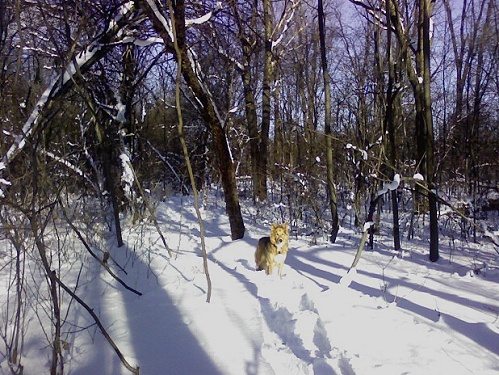|
|
|
WINTER
POPULATION MONITORING |
Welcome
to the McGill Bird Observatory weekly report. Click
here for a complete listing of our archives. Comments or questions are welcome at mbo@migrationresearch.org.
|
PICTURE OF
THE WEEK: |
|

Ordinarily we don’t allow dogs on site to avoid the horrors that
domestic animals can
sometimes wreak on wildlife, but since we’re not banding this
winter, and since she needed
to be walked, Daisy was allowed to come along on a path-clearing
snowshoe. Those of
you who keep track of the weather will realize that this photo
was taken in December, but
our hands were tied since no photos were taken in November!
(Photo by Marie-Anne Hudson)
-
|
|
|
THIS MONTH |
THIS WINTER |
2007 TOTAL |
SITE TOTAL |
|
# birds (and species) banded |
- |
- |
3660 (87) |
12978 (103) |
|
# birds (and species) repeat |
- |
- |
677 (49) |
2226 (59) |
|
# birds (and species) return |
- |
- |
131 (24) |
331 (29) |
|
# species observed |
36 |
36 |
165 |
191 |
|
# net hours |
- |
- |
7923 |
21945.8 |
|
# birds banded / 100 net hours |
- |
- |
46.2 |
59.1 |
|
|
Note: table does
not include nocturnal banding (owls) |
Banders-in-charge: Marie-Anne
Hudson
Censusers: Gay Gruner, Barbara and Don MacDuff, Chris Murphy,
Greg Rand
Notes: Though this winter’s activities have had to be
cut back due to funding and time constraints, we’ve still managed to
keep tabs on our feathered friends by running weekly censuses throughout
November. Some species finally appeared after being ‘missed’ during our
fall season: Bohemian Waxwing and Snow Goose (both lone birds, the Snow
Goose a blue phase hidden within a flock of Canada Geese).
Other interesting observations: a plucky little
muskrat preening itself along the pond, a coyote trotting along the
fence line, a male white-tailed deer finally allowing itself to be seen,
and a Merlin happily munching a European Starling not 5 metres from the
census trail.
Here’s hoping December, with all its snow, will
bring in some special Holiday birds! Large numbers of northern
finches are moving south this winter across much of eastern North
America, and we hope that some of these (and maybe even some owls too)
will put in appearances in the months ahead.
|

